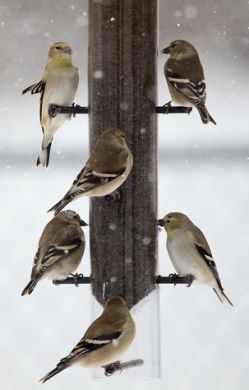Blog - General
Daves February Bird Chatter 2015
Winter is far from over. And as the natural food sources for birds become increasingly scarce or covered by snow, the bird feeders will  continue to draw more visitors. Recent snows to our north may drive more birds into our area, and new ones can arrive at anytime. Keep vigilant about new birds at the feeders. Already this seems to be a banner year for Northern Goldfinch.
continue to draw more visitors. Recent snows to our north may drive more birds into our area, and new ones can arrive at anytime. Keep vigilant about new birds at the feeders. Already this seems to be a banner year for Northern Goldfinch.
The Central Great Plains can receive some of the years heaviest snowfalls in late February and March. If that happens remember that “grit” is essential for birds to digest the seeds they eat.
If the ground becomes covered by snow and ice, mix a little grit with the bird feed in your feeders or place some in an open space on the ground where it will not become covered with snow.
Some folks have Goldfinch at their feeders while others see few to none. Remember to use fresh Nyjer seed. You may want to try Wild Bird Habitat’s finch mix, 50% Nyjer thistle and 50% fine sunflower chips. Remember however if squirrels are a problem the ground sunflower chips will get their attention in a hurry and you may end up with a destroyed thistle feeder. We recommend using some form of squirrel protection when using our finch mix. Over the past several years it seems Goldfinch really like Nutra-Safflower. Try Nutra-Saff in a seed tube bird feeder. By months end and into early March the numbers of Goldfinch at the feeders will increase dramatically. Our adults who drifted south for the winter will be returning, and the northern finches that have been visiting us during the winter will remain here until early May. This period of transition is commonly referred to as finch season.
Suet will become even more popular now that winter has really set in, and will continue to be so through all of spring and well into the summer months. Woodpeckers consume about 30% more animal protein from late winter to mid summer than all winter long. The Downy and Hairy Woodpeckers seem to prefer suet, while the Red-bellied Woodpecker will spend more time feeding on peanuts and woodpecker nut mixes. Make suet and peanuts available for these birds. Nuthatches and Chickadees will eagerly feed on these products as well as the Carolina Wrens that seem to winter over more and more in the Eastern Plains states and Midwest.
Many people have reported a large number of Eastern Bluebirds wintering over. Evidently these birds have an adequate food source of berries to sustain them. If winter intensifies or their natural food source decreases they may drift off to other locations. Some folks have provided them with suet nuggets containing insects and meal worms or just live mealworms. But the fresh open waters of a heated bird bath seems to attract them the most. There is some advantage to keeping your bluebird boxes available during the winter as bluebirds and other cavity nesting birds will use nest boxes as evening roosts during harsh weather. Just be sure to have them cleaned out and ready for the nesting season by the beginning of March when those bluebirds that drifted south will begin to arrive.
Keep water available for your birds as open water will attract more birds than just feed alone. And as food resources diminish into late winter, the bird feeders will become even more popular with birds. Keep them stocked. After all, it will be mid to late summer before many of our bird’s natural food supplies have been replenished.
Have you been enjoying feeding the birds in your backyard? Next time you have a guest over, share that excitement with them. National Bird Feeding Month is a great time to get someone interested in feeding birds. Bird feeders make great birthday gifts, and are excellent Valentines Day presents for the one you love. Enjoy nature together. Have your kids and their friends count birds during the Great Backyard Bird Count. Take a bird walk at the Pioneers Park Nature Center, Enjoy birding more and remember to feed the birds. It makes a world of difference.
